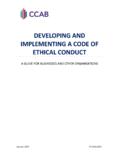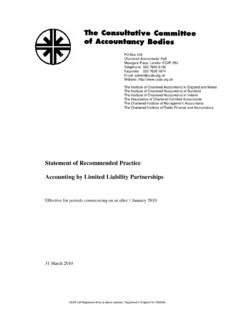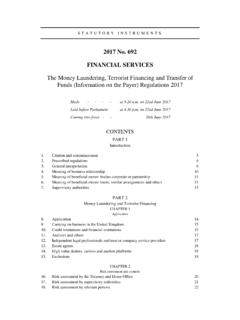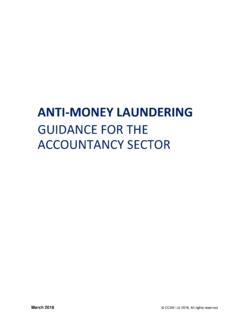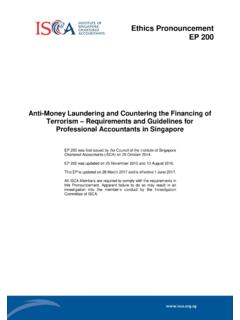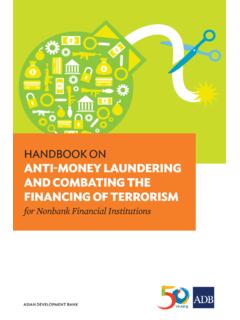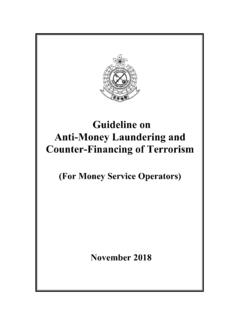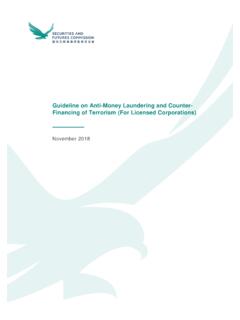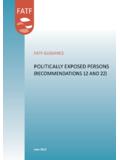Transcription of Anti-Money Laundering and Counter-Terrorist Financing ...
1 1 Anti-Money Laundering and Counter-Terrorist Financing Guidance for the Accountancy Sector Anti-Money Laundering and Counter-Terrorist Financing Guidance for the Accountancy Sector This is draft guidance pending approval from HM Treasury January 2020 Publis hed by CCAB Ltd PO Box 433 Moorgate Place London EC2P 2BJ United Kingdom 2020 CCAB Ltd All rights reserved. If you want to reproduce or distribute any of the material in this publica tio n you should obtain CCAB s pe rmission in writing. CCAB will not be liable for any reliance placed on the information in this report.
2 1 Anti-Money Laundering and Counter-Terrorist Financing Guidance for the Accountancy Sector INTRODUCTION Accountants are key gatekeepers for the financial system, facilitating vital transactions that underpin the UK economy. As such, we have a significant role to play in ensuring our services are not used to further a criminal purpose. As professionals, accountants must act with integrity and uphold the law, and must not engage in criminal activity. This guidance is based on the law and regulations as of 10 January 2020. Please note that some of the requirements of the regulations relating to EU lists are expected to fall away at the end of the transitional period.
3 This guidance covers the prevention of money Laundering and the countering of terrorist Financing . It is intended to be read by anyone who provides audit, accountancy, tax advisory, insolvency, or trust and company services in the United Kingdom and has been approved and adopted by the UK accountancy AML supervisory bodies. The guidance has been prepared jointly by the CCAB bodies: Institute of Chartered Accountants in England and Wales Association of Chartered Certified Accountants Institute of Chartered Accountants of Scotland Chartered Accountants Ireland The Chartered Institute of Public Finance and Accountancy It has been approved and adopted by the UK accountancy supervisory bodies.
4 Institute of Chartered Accountants in England and Wales Association of Accounting Technicians Association of Taxation Technicians Association of International Accountants Institute of Certified Bookkeepers Chartered Institute of Management Accountants 2 Anti-Money Laundering and Counter-Terrorist Financing Guidance for the Accountancy Sector Institute of Financial Accountants International Association of Bookkeepers Association of Chartered Certified Accountants Chartered Institute of Taxation Insolvency Practitioners Association Insolvency Service HM Revenue & Customs Institute of Chartered Accountants of Scotland Chartered Accountants Ireland - Note: A Tax Appendix exists as supplementary guidance and should be consulted by tax practitioners link: : An Insolvency Appendix exists in draft form, pending HMT approval, so should be consulted by insolvency practitioners as supplementary guidance.
5 Link: 3 Anti-Money Laundering and Counter-Terrorist Financing Guidance for the Accountancy Sector CONTENTS 1 ABOUT THIS GUIDANCE 5 What is the purpose of this guidance? 5 What is the scope of this guidance? 6 What is the legal status of this guidance? 9 2 MONEY Laundering AND TERRORIST Financing 10 What are the fundamentals? 10 What are criminal property and terrorist property? 12 What are the Primary Offences? 13 What is the Failure to Report offence? 14 What is the Tipping Off offence? 15 What is the Prejudicing an Investigation offence?
6 15 3 RESPONSIBILITY & OVERSIGHT 17 What are the responsibilities of a business? 17 What does Regulation 26 require of beneficial owners, officers and managers (BOOMs)? 18 What are the differences in requirements for sole practitioners? 20 What are the responsibilities of Senior Management/MLRO? 20 How might the MLRO role be split? 23 What policies, procedures and controls are required? 23 4 RISK BASED APPROACH 29 What is the role of the risk-based approach? 29 What is the role of senior management? 29 How should the risk assessment be designed?
7 30 What is the risk profile of the business? 31 How should procedures take account of the risk-based approach? 32 What are the different types of risk? 33 Why is documentation important? 35 5 CUSTOMER DUE DILIGENCE (CDD) 36 What is the purpose of CDD? 36 When should CDD be carried out? 43 How should CDD be applied? 45 Can reliance be placed on other parties? 51 What happens if CDD cannot be completed? 54 What are the obligations to report discrepancies in the People with Significant Control register? 56 6 SUSPICIOUS ACTIVITY REPORTING 59 What must be reported?
8 59 What is the Failure to Report Offence? 62 What is the Tipping Off Offence? 63 What is the Prejudicing an Investigation Offence? 65 When and how should an external SAR be made to the NCA? 65 4 Anti-Money Laundering and Counter-Terrorist Financing Guidance for the Accountancy Sector What is a DAML and why is it important? 74 What should happen after an external SAR has been made? 77 7 RECORD KEEPING 81 Why may existing document retention policies need to be changed? 81 What should be considered regarding retention policies? 81 What considerations apply to SARs and DAML requests?
9 81 What considerations apply to training records? 82 Where should reporting records be located? 82 What do businesses need to do regarding third-party arrangements? 82 What are the requirements regarding the deletion of personal data? 82 8 TRAINING AND AWARENESS 83 Who should be trained and who is responsible for it? 83 Who is an agent? 83 What should be included in the training? 84 When should training be completed? 86 9 GLOSSARY & APPENDICES 87 Glossary 87 APPENDIX A: Subcontracting and Secondments 94 APPENDIX B: Client Verification 95 APPENDIX C: When to make a SAR 99 APPENDIX D: risk factors per regulations 33(6) & 37(3) 100 APPENDIX E: client due diligence case studies 103 5 Anti-Money Laundering and Counter-Terrorist Financing Guidance for the Accountancy Sector 1 ABOUT THIS GUIDANCE What is the purpose of this guidance?
10 Who is the guidance for? What is the legal status of this guidance? What is the purpose of this guidance? This guidance has been prepared to help accountants (including tax advisers and insolvency practitioners) comply with their obligations under UK legislation to prevent, recognise and report money Laundering . Compliance with it will ensure compliance with the relevant legislation (including that related to Counter-Terrorist Financing ) and professional requirements. The term must is used throughout to indicate a mandatory legal or regulatory requirement. If Businesses require assistance in interpretation of the UK Anti-Money Laundering and terrorist Financing (AML) regime, they should seek advice from their Anti-Money Laundering supervisory authority or consider seeking legal advice.



